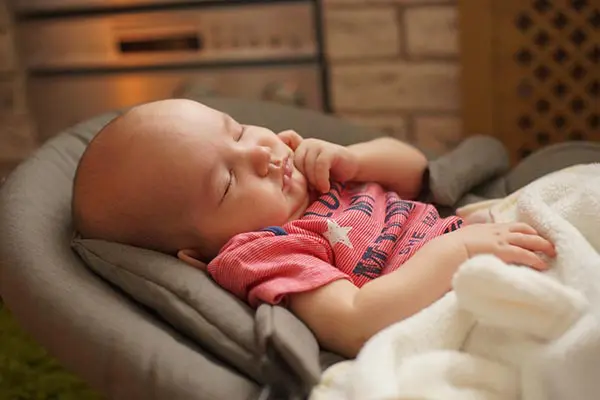No matter how snuggly your baby is, at some point you’ll need to put down that little bundle of joy so you can fry bacon/mop the floor/go potty by yourself. As most seasoned parents can attest, swings and bouncers can both be real lifesavers for busy families.
But buying a baby swing or bouncer isn’t as simple as heading to the store. As you start the shopping process, you’ll quickly realize you have no shortage of options: Batteries or plug-in? Do you want motion? Do you need music? And what about extras like toy bars?
Never fear: Below, we’ve created the ultimate buying guide for choosing the right bouncer or swing for your baby and your lifestyle. We’ve also spotlighted a few of our favorites to get you started.
DO YOU NEED A BABY BOUNCER OR A SWING?
Baby swings and baby bouncers are both popular among parents—and because they serve slightly different purposes, you may actually want one of each! However, if your budget allows for one, here’s what to consider:
Bouncers take up less space. If you have a small home or simply worry about a tide of baby gear taking over, you may prefer a compact bouncer to a bulkier swing.
Bouncers offer easier portability. If you want a spot for baby while you’re working in the kitchen and then to move it to the bathroom while you shower, a bouncer is what you want.
Swings are better for soothing to sleep. If your goal is to lull a tired baby to sleep, opt for a swing; if you simply want a place for baby to wiggle happily while you wash dishes, choose a bouncer. Some parents also find that swings help calm irritable or fussy babies.
TYPES OF BABY BOUNCERS
As baby gear goes, a bouncer (also called a bouncer seat or bouncy seat) is fairly simple: just a little seat where your baby can chill while you get something done. But there are a few different types to consider.
Battery-Operated Baby Bouncers
These bouncers feature a vibrating motion that some babies find soothing. Some also feature sounds and music. If your baby enjoys this type of stimulation, spending a bit more may be worth it.
Baby Bouncer-Rockers
These combo models are essentially bouncers that you can convert into rocking chairs. This makes them useful for a longer period of time.
Natural Baby Bouncers
These bouncy seats rock naturally, no batteries required. Some are simple, without many bells and whistles, while others are more of a splurge due to their thoughtful design.
Baby Bouncer-Swings
If you’re on the fence about buying a bouncer versus a swing, this combination product may be your answer. You can use the seat as a bouncer and then attach it to the frame to convert it to a swing.
FEATURES TO CONSIDER
Here’s what to research and watch for when you’re shopping for a bouncy seat.
Safety straps: All bouncers should have secure restraints to keep baby from falling out. A three-point harness is necessary, and a five-point harness offers even better protection.
No-tip base: Look for a wide, sturdy base to minimize the risk of the seat tipping over. You will also a base that has a skid free base so it doesn’t slide on surfaces.
Adjustable sounds: If you choose a battery-operated bouncer, look for a model with adjustable sounds, vibration speed, and volume so you can tailor it to your baby’s preferences.
Toy bar: This optional feature is ideal for babies who like to play; just make sure the toys are secure.
USE YOUR BABY BOUNCER SAFELY
It’s important to use your bouncer properly to avoid safety issues. The American Academy of Pediatrics (AAP) notes that baby bouncers should always be left on the floor—never on an elevated surface such as a countertop or table. This also includes soft surfaces like beds, as they can be a suffocation hazard if a bouncer tips.
Adjust the restraints carefully and never skip using them. Keep in mind the bouncer is not a babysitter—you need to stay nearby and keep an eye on your baby. Follow the bouncer’s guidelines regarding weight limits, and make sure to discontinue use when your baby can sit up independently, as that could cause the bouncer to tip or even allow your baby to fall out.
PRO TIP: Swings and bouncers are not designed for naptime. According to the AAP, babies younger than four months are at particular risk for positioning that causes airway obstruction or suffocation risk. If your baby falls asleep in the swing or bouncer, you should move him to his bassinet or crib for safety.
TYPES OF BABY SWINGS
Once an optional piece of baby gear, baby swings have evolved into a parental favorite for their almost-magical ability to soothe infants. When you’re shopping, you’ll have several options.
Full-Size Baby Swings
These swings often have more bells and whistles than their portable counterpart. If you don’t plan to take your swing on many trips, you’ll likely want to go with a full-size model.
Travel Baby Swings
These portable units are smaller and fold up easily for simple transport. This is an excellent option if you travel often and want a swing you can use at a hotel or at Grandma’s house.
BABY SWING FEATURES TO CONSIDER
Batteries or AC power: Most swings take batteries, but some drain them more quickly than others. A plug-in option can save you some money.
Swing direction: Some babies like side-to-side motion; others like front-to-back swaying. Some models offer both—and a few have different motions entirely, such as up-and-down or circular.
Recline options: Newborns should be fully reclined, while older babies can sit up more.
Multiple speeds: The best swings offer several speeds because some infants like slow rocking while others prefer a quicker pace.
Motor noise: Some swings have noisier motors than others. If you’re sensitive to sounds, be sure you choose one with a quiet motor.
Extras: Toy bars, trays, melodies, nature sounds, lights, mobiles—the sky’s the limit when it comes to these special features.
USE YOUR BABY SWING SAFELY
According to the AAP, taking some simple steps can increase baby swing safety. Make sure the swing you choose will not easily tip or fold up, watch for sharp edges, double-check that any toys can’t be removed by eager little hands.
Carefully follow the usage instructions, including specified weight limits. If your baby is under four months, make sure the swing is in the most reclined position to avoid suffocation risk if she slumps. Always use safety restraints to ensure your baby won’t fall out. Watch older siblings, and help them understand the swing is not a toy to push.
Before you purchase a baby bouncer or a baby swing, be sure you check the U.S. Consumer Product Safety Commission recall list to ensure the one you choose has not been recalled.
PRO TIP: Bouncers and swings can be a lifesaver. However, keep in mind that they are not a substitute for tummy time. Starting from day 1, you need to make sure to put your baby on her tummy (while she’s awake) for about three to five minutes at a time, two to three times a day. Watch her, talk to her, and play with her while she does this—the hope is that she’ll learn to love it!



